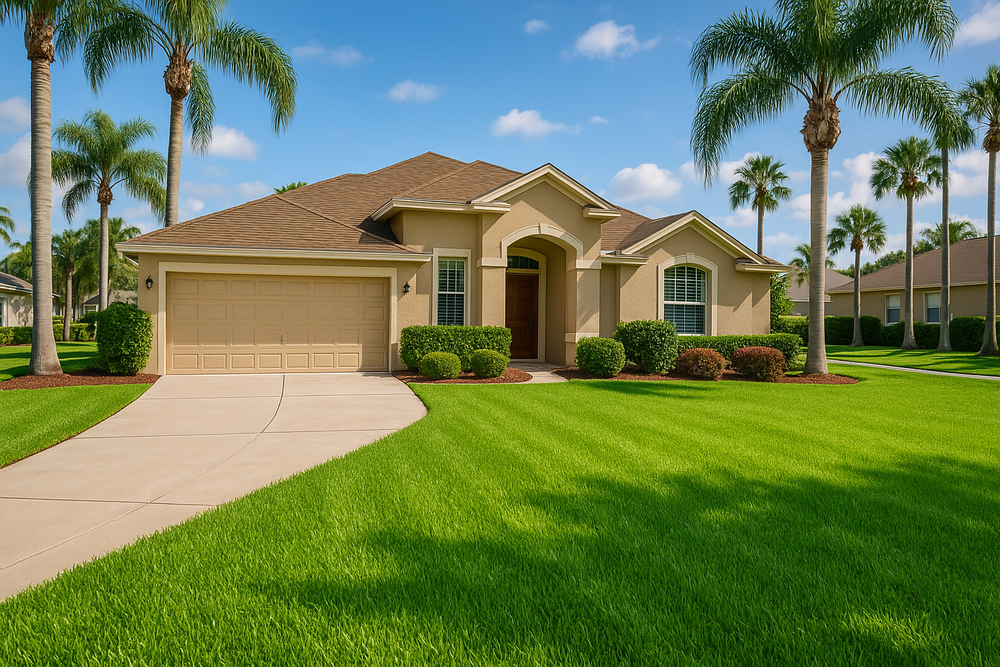Orlando Sod Guide: Best Grass Types & Lawn Care Tips for Central Florida
Posted by Farm2Yard on Sep 18th 2025
Orlando Sod Guide: Choosing and Maintaining the Best Grass for Central Florida
If you live in Orlando, you know lawns here are more than just landscaping - they’re a year-round investment. Central Florida’s climate, rainfall patterns, and sandy soils create unique challenges for homeowners who want a healthy, green yard. This sod guide covers which grasses thrive in Orlando, how to care for them through the seasons, and the best time to lay new sod.
Orlando’s Climate and What It Means for Sod
Orlando is located in USDA Hardiness Zone 9b and falls into a humid subtropical climate. Summers are long, hot, and humid with average highs in the 90s, while winters are mild with rare freezes. Annual rainfall averages about 52 inches, with most falling between June and September during afternoon thunderstorms (National Weather Service).
For turfgrass, this means:
-
Heat and humidity tolerance are essential.
-
Soil drainage matters. Orlando’s sandy soils drain quickly, so sod types must withstand occasional drought stress.
-
Shade tolerance is valuable. Many Orlando lawns have mature trees that limit direct sun.
-
Disease pressure is high. Warm, wet summers increase risk of fungal diseases like brown patch and gray leaf spot.
Best Sod Types for Orlando, FL
According to the University of Florida IFAS Extension turfgrass guide, several warm-season grasses perform well in Orlando. Each has strengths and trade-offs:
St. Augustinegrass
The most widely used turfgrass in Florida, St. Augustine handles heat, humidity, and salt. Popular cultivars in Orlando include:
-
Floratam – Best for full sun, coarse texture, drought tolerant.
-
ProVista – Semi-dwarf variety, good for moderate shade.
-
CitraBlue – Superior shade and disease resistance.
Pros: Shade tolerance (depending on cultivar), quick establishment, lush look.
Cons: High water and fertility needs, susceptible to chinch bugs.
Bermudagrass
Common on sports fields and sunny lawns, Bermuda is fast-growing and resilient.
-
Celebration – Deep blue-green, drought-tolerant, excellent wear recovery.
-
Tifway 419 – Fine-textured, dense growth.
Pros: Handles heavy foot traffic, drought resistance, fast recovery.
Cons: Requires full sun, aggressive growth (needs edging), prone to weeds if not maintained.
Zoysiagrass
An increasingly popular choice for Orlando homeowners.
-
Empire – Medium-blade, drought tolerant, dense canopy.
-
Geo – Fine-textured, shade tolerant.
Pros: Very drought tolerant, dense growth reduces weeds, moderate shade tolerance.
Cons: Slower to establish, can develop thatch if over-fertilized.
Bahiagrass
A lower-maintenance option suited to large lots and utility areas.
Pros: Excellent drought and pest resistance, low fertility needs.
Cons: Coarser appearance, not as lush as St. Augustine or Zoysia.
How Orlando’s Weather Impacts Sod Selection
-
Summer storms: Heavy rainfall can cause leaching of nutrients, so fertilization must be carefully timed (UF/IFAS lawn fertilization guide).
-
Heat stress: Choose cultivars bred for drought tolerance to reduce irrigation needs.
-
Humidity-driven diseases: St. Augustine is especially vulnerable; fungicide applications may be needed in summer.
-
Mild winters: Warm-season grasses stay green longer, but frost can cause temporary dormancy.
Seasonal Lawn Care in Orlando
Spring (March–May)
-
Fertilize with a balanced slow-release nitrogen source when growth resumes.
-
Apply pre-emergent herbicides in early spring to reduce summer weeds.
-
Irrigate deeply 2x per week if rainfall is lacking.
Summer (June–September)
-
Mow frequently (St. Augustine: 3.5–4 inches, Bermuda: 1–1.5 inches, Zoysia: 1–2 inches).
-
Watch for disease (brown patch, gray leaf spot) and insects like chinch bugs.
-
Water early morning to avoid fungal outbreaks.
Fall (October–November)
-
Apply potassium-rich fertilizer to strengthen roots before winter.
-
Reduce mowing frequency as growth slows.
-
Overseed with ryegrass if you want green winter color (optional).
Winter (December–February)
-
Minimal growth; mow sparingly.
-
Irrigation needs are lower - about once every 10–14 days if rainfall is absent.
-
Avoid nitrogen fertilization to prevent cold stress.
Best Time of Year to Lay Sod in Orlando
According to UF/IFAS establishment guidelines, sod can be installed year-round in Central Florida, but spring and early summer are best. Warm soil promotes rapid root establishment, and consistent rainfall reduces irrigation needs.
-
Spring (March–May): Optimal combination of temperature and moisture.
-
Summer (June–August): Sod establishes quickly but requires diligent watering due to heat.
-
Fall (September–November): Still acceptable, but avoid late fall if frost is possible.
-
Winter (December–February): Slower establishment, but mild Orlando winters make it feasible.
Additional Tips for Orlando Sod Success
-
Test your soil before installation (UF/IFAS soil testing lab). Sandy soils often require lime to balance pH.
-
Install irrigation zones that cover all areas evenly - especially corners and edges.
-
Follow UF/IFAS Landscape and Irrigation Recommendations to conserve water and reduce chemical use.
-
Mulch around trees to reduce competition for water between turf and roots.
-
Avoid overwatering. More than ½–¾ inch per irrigation event can cause nutrient leaching and fungus.
Conclusion
Orlando homeowners have many sod options, from lush St. Augustine to resilient Bermuda and drought-tolerant Zoysia. The key is matching your lawn’s conditions - sun, shade, traffic, and soil - to the right grass. By following seasonal maintenance and UF/IFAS Extension recommendations, your lawn can thrive in Central Florida’s challenging but rewarding climate.

